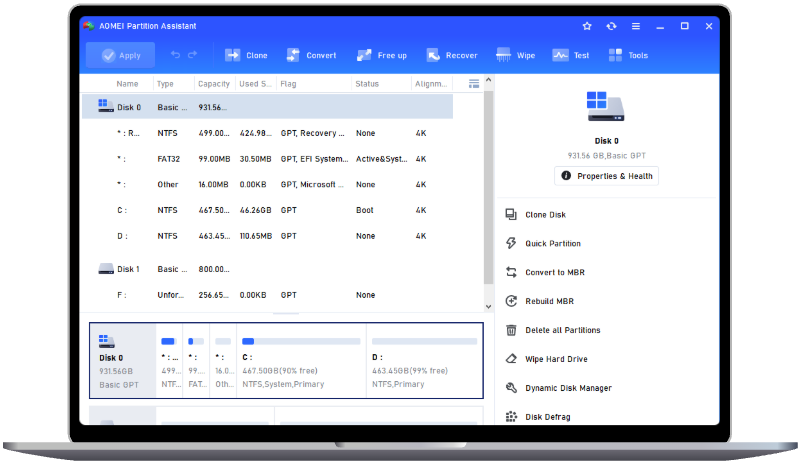How to Shrink Primary Partition in Windows 10?
This is a comprehensive guide about how to shrink primary partition in Windows 10. You can also know what is it and whether it is safe to shrink primary partition in Windows 10.
User case: Is it safe to shrink primary partition in Windows 10?
I need to shrink my primary ext4 partition, but I want to be sure I won't accidentally lose data. Is it safe to shrink a partition that contains data, as long as there is enough free space? My partition is 922GB, and I want to shrink it by about 250GB. However, I’m worried that data might be lost due to how it's distributed across the partition, such as fragmentation. How does this process work?
- Question from Reddit
Managing your disk space efficiently can significantly enhance your computer’s performance and organization. One common task is to shrink a primary partition in Windows 10—a process that creates unallocated space which can then be used for additional partitions or extended volumes. However, is it safe to shrink primary partition in Windows 10? Shrinking a primary partition is generally safe. If you want to know how to shrink primary partition in Windows 10, you can move to the next part.
How to shrink primary partition in Windows 10 without losing data?
Windows 10 offers built-in tools like Disk Management to resize partitions. However, many users often find themselves unable to shrink a primary partition due to unmovable files, such as page files and hibernation files. These files are essential for system functionality and cannot be easily relocated or removed. Otherwise, data loss may occur.
If you want to safely shrink a primary partition in Windows 10, using a professional tool like AOMEI Partition Assistant is recommended. Unlike built-in Windows tools, it uses advanced methods to shrink partitions with unmovable files. Its 1-Click Adjust Space feature makes managing free space easy—simply drag the edges of a partition to resize it quickly and efficiently. Additionally, the tool allows you to modify multiple partitions at once, streamlining the process for greater convenience.
The Best Windows Disk Partition Manager and PC Optimizer
Step 1. Install and launch AOMEI Partition Assistant. Right-click a partition (here is D: partition) you want to adjust space and select "1-Click Adjust Space".
Note: It cannot select unallocated space to adjust because the feature is just for partition space adjustment. If there is unallocated space and you want to use it to expand a partition, you can use the feature "Merge Partition".
Step 2. If you want to use the space on F: to expand D: you can simply drag the dot near the partition F: head backward to shrink the partition F: and enlarge the partition D: simultaneously. Then click "OK". You can simultaneously drag the dot near the partition C: tail forward to shrink the partition C: so the D: will also be enlarged with the space of C: at the same time. In this case, you can adjust all partition space (C:, D:, and F:) on the disk.
Step 3. You can preview the operation by viewing the "Pending Operations". To commit the "Pending Operations", please click "Apply" and "Proceed".
Step 4. The process will start and you can check the progress. It might take time to finish the operation.
Step 5. Wait for the operation to be finished. After it is completed successfully, you will find D: is enlarged and both D: and F: are adjusted.
Bonus tips: More options of AOMEI software in Windows 10
Users want to shrink primary partition in Windows 10 often because they need to optimize disk space usage, enhance system performance, or preparing for dual boot. AOMEI Partition Assistant offers various options for reaching these goals easily.
The Best Windows Disk Partition Manager and PC Optimizer
Option 1. Allocate free space
Sometimes, users shrink partitions to free up space for other partitions, especially if one is running low while others have excess space. You can allocate free space to the full drive without deleting anything as well.
Option 2. Enhance system performance
If you want to enhance system performance, you can directly transfer OS to SSD. AOMEI Partition Assistant offers this function as well.
After cloning, you need to boot Windows from the new SSD. If the computer has only one slot, you can start the computer after installing the SSD. But if the computer has multiple slots, after installing the SSD, you need to set the SSD as the boot drive.
Conclusion
This article introduce how to shrink partition in Windows 10 and explain whether it is safe to shrink it. Shrinking a primary partition in Windows 10 is generally safe if done correctly. While built-in tools like Disk Management have limitations, professional software such as AOMEI Partition Assistant provides a more efficient and flexible solution. By using advanced methods, it allows you to resize partitions without risking data loss. Whether you need to free up space, optimize system performance, or prepare for a dual-boot setup, AOMEI Partition Assistant offers a reliable and user-friendly way to manage your disk partitions effectively.


